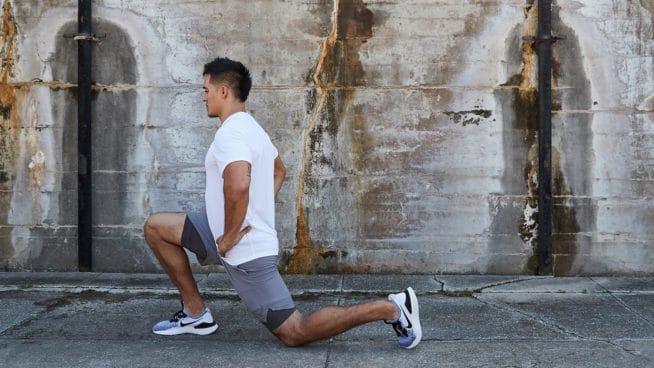Your Complete HIIT Training Guide
What is HIIT Training?
HIIT is an acronym for “high-intensity interval training,” which refers to a workout technique that mixes bouts of hard or all-out effort with short periods of rest. The phrase “HIIT training” is a colloquial way to refer to HIIT workouts, although if you were to actually say all of the words in the acronym out loud, it would create an awkward redundancy (“high-intensity interval training training” would be the result).
HIIT sessions have been proven to be one of the most effective (and time-efficient) methods for increasing endurance, burning calories and improving overall fitness. Some HIIT workouts can be completed in as little as four minutes.
Since 2014, the American College of Sports Medicine has listed high-intensity interval training as a top fitness trend. Its meteoric rise in popularity is due largely to the fact that HIIT solves people’s’ desire to get the greatest results in as little time spent working out as possible.
But make no mistake, this type of training is not easy. HIIT only works if you push yourself out of your comfort zone, so the workouts are often unpleasantly difficult. However, it’s an effective style of training that offers more fitness benefits than traditional cardio conditioning workouts.
How Does HIIT Training Work?
All HIIT workouts are based on the same premise. Exercise intervals are performed at an intensity of at least 80 percent of your max heart rate for a specified time, followed by a recovery interval in which you rest or perform a low-intensity activity such as walking. When you push your body in such a manner, your energy systems kick into high gear to create energy needed for your body to perform.
The anaerobic energy system uses stored energy to power high-intensity exercise. You’re able to maintain max effort work for about 10 seconds and moderately high effort work for 2 to 3 minutes. Fatigue sets in as you continue to perform at a high percentage of your max, and eventually you experience the dreaded burning sensation in your working muscles.
The aerobic system kicks into high gear between sets. This system uses oxygen to create a source of energy for low-intensity activity for long durations, such as walking or jogging. However, it’s also replenishes the spent fuel used during anaerobic activity, which helps you recover and continue performing several sets of intense exercise.
Read more about how our body produces energy here.
The on-and-off structure of HIIT allows you to perform at close to max effort for a longer duration (all your sets added up) than would otherwise be possible, conferring many benefits that cannot be replicated with other types of training.
Conditioning Benefits of HIIT Training
HIIT workouts have been found to produce the same or greater aerobic endurance improvements as cardio workouts, which take as much as ten times longer to complete. They also improve the anaerobic energy system, which delays the onset of fatigue and muscle burn when performing max-effort activities.
Dr. Izumi Tabata found that a four-minute workout with 8 sets of 20 seconds at max capacity interspersed with 10 seconds of rest increased aerobic performance by 14.5 percent and anaerobic performance by 28 percent, whereas a 60-minute cardio workout improved aerobic performance by only 9 percent. Many other studies show similar improvements, which are summed up in this meta-analysis.
Put simply, your body gets better at producing energy when you work at all levels of intensity.
The result is improved work capacity—the ability to work at a higher intensity for a longer duration.You are able to work at a greater percentage of your max when you perform your workout or play your sport—and recover faster between exercises or plays.
For this reason, HIIT is the ideal form of conditioning for most athletes. It develops the endurance for repeated Sprints, Jumps and other powerful movements, whereas research shows that cardio workouts may actually make you slower and decrease strength and lean muscle mass.
Weight Loss Benefits of HIIT
Since HIIT workouts are performed at a high intensity, your body naturally burns more calories than it does when you perform lower intensity exercise. But the total work performed in a HIIT workout is limited, so most experts point to the “afterburn effect” of HIIT.
After an HIIT workout, your body consumes more oxygen to restore spent fuel sources, repair itself and adapt to the stress just placed on it. This phenomenon is called Excess Post-Exercise Oxygen Consumption, or EPOC. During EPOC, your body burns more calories than you normally do at rest. In theory, HIIT puts your body in greater oxygen debt than an aerobic workout. A brief HIIT workout should have a greater net energy cost, because it elevates your metabolism more than a longer aerobic workout, due to the afterburn effect, which helps you achieve a caloric deficit—the key to losing weight.
Research has shown EPOC may last up to 24 hours (the effect appears to decrease over time), but may increase the total energy cost of the workout by only 15 percent. More research must be done to determine exactly how many extra calories are burned after an HIIT workout, since much of this data is inferred from studies assessing cardio and resistance training workouts.
HIIT has also been shown to increase fat burn. In fact, one study found a ninefold increase in fat burn with HIIT compared to cardio workouts. Other studies have confirmed that HIIT is a far superior fat burner than cardio.
Other Benefits of HIIT Training
HIIT improves insulin sensitivity. Improved insulin sensitivity helps shuttle more of the food you eat to your muscles, and not store it as fat. Improving insulin sensitivity is one of the keys to preventing diabetes.
HIIT improves nervous system response. HIIT increases parasympathetic activity, the part of your nervous system that slows down your heart rate, improves digestion and reduces stress.
HIIT makes you tougher. Working near your max makes you tougher. It prepares you to withstand grueling workouts and situations during your sport when you’re pushed to the limit.
To dive deeper into the benefits of HIIT, check out this article, which reviews much of the research published on HIIT training.
HIIT Training Workouts
HIIT workouts vary in interval length, which determines their exact benefits and difficulty. Here are a few popular examples:

HIIT Training Exercises
Another great thing about HIIT is that you can select various types of workouts and perform a wide variety of exercises, depending on your goals.
When choosing exercises, remember that HIIT workouts are meant to push you at or near your max. Doing a few Bicep Curls won’t cut it. You should choose full-body movements that are difficult to perform for several reps. You can opt for traditional conditioning exercises like Sprints, or choose full-body strength exercises to build endurance and improve strength at the same time—although you shouldn’t expect massive strength gains from this style of training.
Most important, choose an exercise that you have mastered. HIIT is designed to cause fatigue and will cause your form to degrade, so it’s important to have a solid foundation before working at extremely high intensities.
Here are some of the most popular exercises to incorporate into HIIT workouts:
Stationary Bike
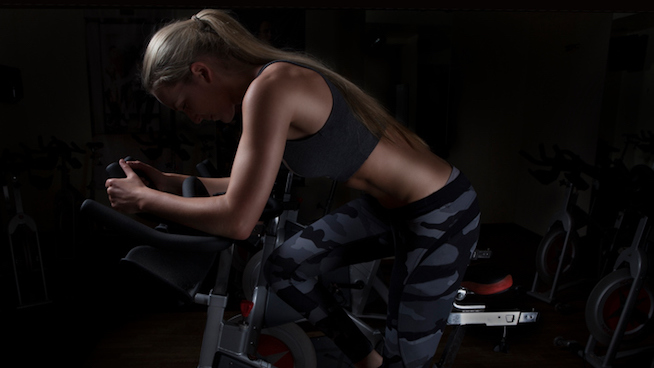
Most of the research on HIIT is performed on stationary bikes, because they facilitate accurate measures of workload and intensity. For your own workouts, stationary bikes are one of the most widely available pieces of equipment in a gym setting, and they place minimal impact on your joints.
Sprints

Sprints are accessible to nearly everyone and are an easy way to push your body. For an added challenge, try running up a hill and walking down to start your recovery.
Burpees
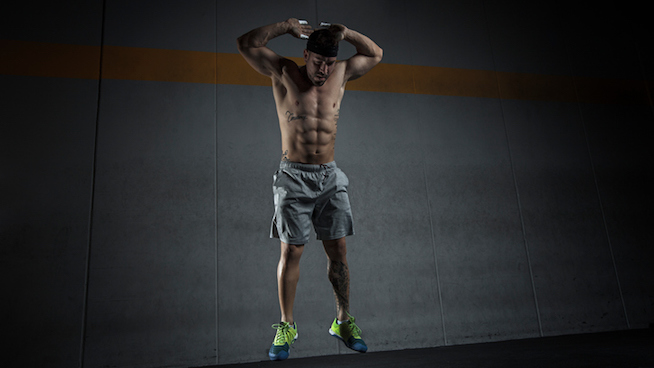
Burpees are arguably the most challenging full-body exercise, and they’re a staple of CrossFit workouts. The exercise is difficult, no doubt. But be careful. You should be able to pass some basic strength and mobility tests before considering Burpees.
Squat to Overhead Press
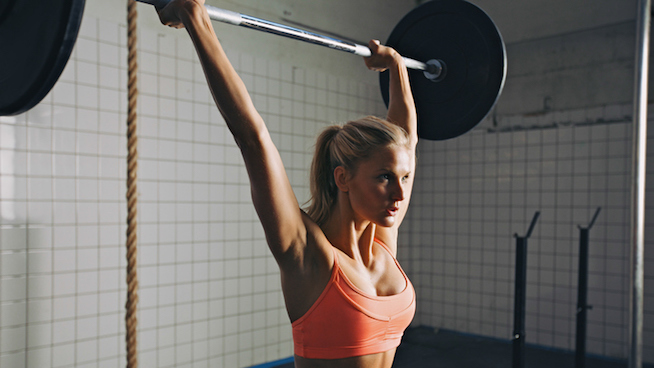
Whether you use a barbell, dumbbells or a med ball, this move is an easy way to challenge both your lower and upper body.
Kettlebell Swings
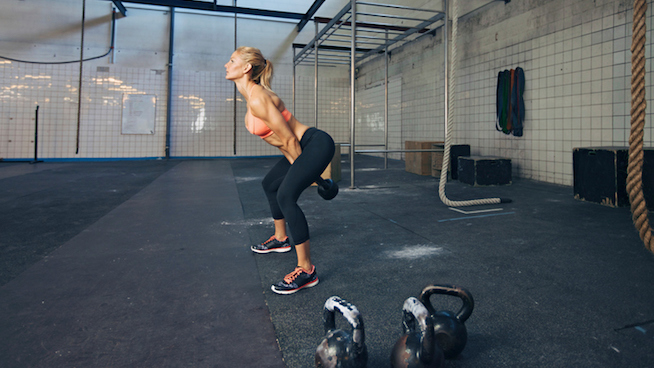
The Kettlebell Swing is another full-body exercise that is popular for HIIT-style workouts, because it’s easy to perform reps over and over again, which is a surefire way to challenge your energy systems.
Bodyweight Exercises
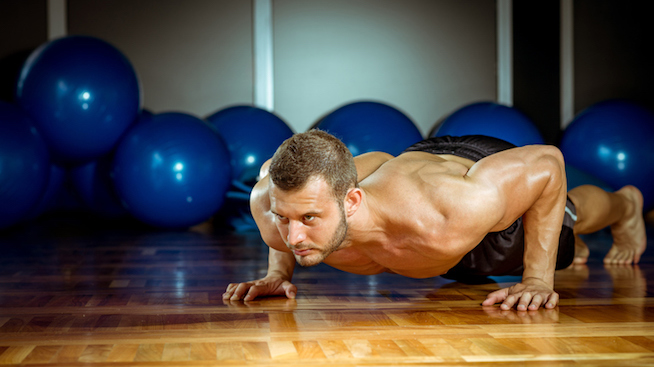
Many bodyweight exercises—such as Push-Ups, Squats, Squat Jumps and Bear Crawls—make great HIIT exercise options. However, to avoid too much fatigue, you will have to choose an HIIT workout with short work intervals and longer rest periods—or perform more than one type of exercise. Watch the video above to see an example of how to pair multiple exercises in an interval circuit.
Avoid: Olympic Lifts
Although Olympic lifts are often performed in HIIT workouts, we advise you to avoid this type of exercise. Cleans and Snatches are technical movements, and they should be performed only when you are fully recovered or you run the risk of injury. So unless you are using a very light weight, it’s not a smart decision.
HIIT Training Timers
To properly perform HIIT workouts, you need some type of timer. You can use a stopwatch or the timer app on your smartphone. Also, several apps and products make it easy to time your workouts.
Seconds Pro
One of the most popular apps on the App Store, Seconds Pro allows you to program your work and rest intervals and the number of sets or total duration of your workout. It comes with templates for popular workouts, sounds an alert the beginning and end of each interval, tracks your heart rate and coordinates music with the workout. The Pro version is available for $4.99, and there’s a free version with limited functionality.
Rogue Echo Gym Timer
The Rogue Echo Gym Timer is a large digital device that allows for custom work and rest intervals. It’s designed for group HIIT workouts in a gym. The $269 price tag isn’t worth it if you’re working out on your own or at home.
Sample HIIT Training Programs
HIIT is becoming one of most prominent ways to work out, and anyone who wants to improve his or her fitness should take advantage of it.
CAUTION: Be careful not to do too much HIIT.
HIIT workouts are designed to stress the body and cause it to adapt. But if you place too much stress on your body too frequently, you can become overtrained. This leads to a cascade of problems—muscle breakdown, grogginess, fatigue and increased risk for injury—nothing you want if you’re an athlete or if you’re committed to a workout program.
Below are three options for structuring an HIIT training program. You’ll notice that the same HIIT workout isn’t repeated during the week. This is meant to develop different components of your energy systems.
Also, when HIIT is paired with strength training, it’s best to stick to one HIIT workout per week (no more than two), or you run the risk of impairing your strength and muscle size gains.
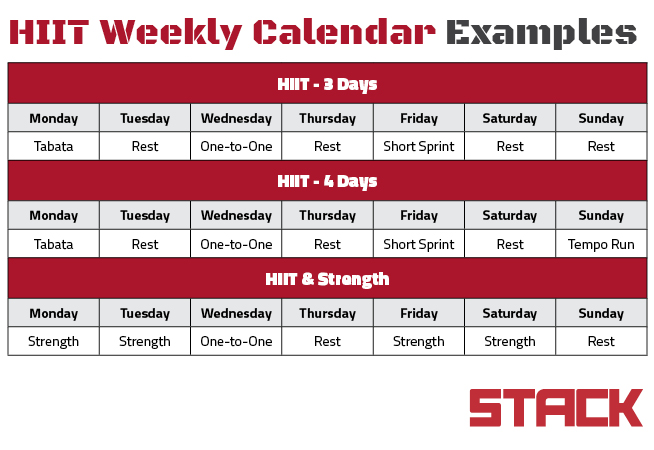
RELATED LINKS:
RECOMMENDED FOR YOU
MOST POPULAR
Your Complete HIIT Training Guide
What is HIIT Training?
HIIT is an acronym for “high-intensity interval training,” which refers to a workout technique that mixes bouts of hard or all-out effort with short periods of rest. The phrase “HIIT training” is a colloquial way to refer to HIIT workouts, although if you were to actually say all of the words in the acronym out loud, it would create an awkward redundancy (“high-intensity interval training training” would be the result).
HIIT sessions have been proven to be one of the most effective (and time-efficient) methods for increasing endurance, burning calories and improving overall fitness. Some HIIT workouts can be completed in as little as four minutes.
Since 2014, the American College of Sports Medicine has listed high-intensity interval training as a top fitness trend. Its meteoric rise in popularity is due largely to the fact that HIIT solves people’s’ desire to get the greatest results in as little time spent working out as possible.
But make no mistake, this type of training is not easy. HIIT only works if you push yourself out of your comfort zone, so the workouts are often unpleasantly difficult. However, it’s an effective style of training that offers more fitness benefits than traditional cardio conditioning workouts.
How Does HIIT Training Work?
All HIIT workouts are based on the same premise. Exercise intervals are performed at an intensity of at least 80 percent of your max heart rate for a specified time, followed by a recovery interval in which you rest or perform a low-intensity activity such as walking. When you push your body in such a manner, your energy systems kick into high gear to create energy needed for your body to perform.
The anaerobic energy system uses stored energy to power high-intensity exercise. You’re able to maintain max effort work for about 10 seconds and moderately high effort work for 2 to 3 minutes. Fatigue sets in as you continue to perform at a high percentage of your max, and eventually you experience the dreaded burning sensation in your working muscles.
The aerobic system kicks into high gear between sets. This system uses oxygen to create a source of energy for low-intensity activity for long durations, such as walking or jogging. However, it’s also replenishes the spent fuel used during anaerobic activity, which helps you recover and continue performing several sets of intense exercise.
Read more about how our body produces energy here.
The on-and-off structure of HIIT allows you to perform at close to max effort for a longer duration (all your sets added up) than would otherwise be possible, conferring many benefits that cannot be replicated with other types of training.
Conditioning Benefits of HIIT Training
HIIT workouts have been found to produce the same or greater aerobic endurance improvements as cardio workouts, which take as much as ten times longer to complete. They also improve the anaerobic energy system, which delays the onset of fatigue and muscle burn when performing max-effort activities.
Dr. Izumi Tabata found that a four-minute workout with 8 sets of 20 seconds at max capacity interspersed with 10 seconds of rest increased aerobic performance by 14.5 percent and anaerobic performance by 28 percent, whereas a 60-minute cardio workout improved aerobic performance by only 9 percent. Many other studies show similar improvements, which are summed up in this meta-analysis.
Put simply, your body gets better at producing energy when you work at all levels of intensity.
The result is improved work capacity—the ability to work at a higher intensity for a longer duration.You are able to work at a greater percentage of your max when you perform your workout or play your sport—and recover faster between exercises or plays.
For this reason, HIIT is the ideal form of conditioning for most athletes. It develops the endurance for repeated Sprints, Jumps and other powerful movements, whereas research shows that cardio workouts may actually make you slower and decrease strength and lean muscle mass.
Weight Loss Benefits of HIIT
Since HIIT workouts are performed at a high intensity, your body naturally burns more calories than it does when you perform lower intensity exercise. But the total work performed in a HIIT workout is limited, so most experts point to the “afterburn effect” of HIIT.
After an HIIT workout, your body consumes more oxygen to restore spent fuel sources, repair itself and adapt to the stress just placed on it. This phenomenon is called Excess Post-Exercise Oxygen Consumption, or EPOC. During EPOC, your body burns more calories than you normally do at rest. In theory, HIIT puts your body in greater oxygen debt than an aerobic workout. A brief HIIT workout should have a greater net energy cost, because it elevates your metabolism more than a longer aerobic workout, due to the afterburn effect, which helps you achieve a caloric deficit—the key to losing weight.
Research has shown EPOC may last up to 24 hours (the effect appears to decrease over time), but may increase the total energy cost of the workout by only 15 percent. More research must be done to determine exactly how many extra calories are burned after an HIIT workout, since much of this data is inferred from studies assessing cardio and resistance training workouts.
HIIT has also been shown to increase fat burn. In fact, one study found a ninefold increase in fat burn with HIIT compared to cardio workouts. Other studies have confirmed that HIIT is a far superior fat burner than cardio.
Other Benefits of HIIT Training
HIIT improves insulin sensitivity. Improved insulin sensitivity helps shuttle more of the food you eat to your muscles, and not store it as fat. Improving insulin sensitivity is one of the keys to preventing diabetes.
HIIT improves nervous system response. HIIT increases parasympathetic activity, the part of your nervous system that slows down your heart rate, improves digestion and reduces stress.
HIIT makes you tougher. Working near your max makes you tougher. It prepares you to withstand grueling workouts and situations during your sport when you’re pushed to the limit.
To dive deeper into the benefits of HIIT, check out this article, which reviews much of the research published on HIIT training.
HIIT Training Workouts
HIIT workouts vary in interval length, which determines their exact benefits and difficulty. Here are a few popular examples:

HIIT Training Exercises
Another great thing about HIIT is that you can select various types of workouts and perform a wide variety of exercises, depending on your goals.
When choosing exercises, remember that HIIT workouts are meant to push you at or near your max. Doing a few Bicep Curls won’t cut it. You should choose full-body movements that are difficult to perform for several reps. You can opt for traditional conditioning exercises like Sprints, or choose full-body strength exercises to build endurance and improve strength at the same time—although you shouldn’t expect massive strength gains from this style of training.
Most important, choose an exercise that you have mastered. HIIT is designed to cause fatigue and will cause your form to degrade, so it’s important to have a solid foundation before working at extremely high intensities.
Here are some of the most popular exercises to incorporate into HIIT workouts:
Stationary Bike

Most of the research on HIIT is performed on stationary bikes, because they facilitate accurate measures of workload and intensity. For your own workouts, stationary bikes are one of the most widely available pieces of equipment in a gym setting, and they place minimal impact on your joints.
Sprints

Sprints are accessible to nearly everyone and are an easy way to push your body. For an added challenge, try running up a hill and walking down to start your recovery.
Burpees

Burpees are arguably the most challenging full-body exercise, and they’re a staple of CrossFit workouts. The exercise is difficult, no doubt. But be careful. You should be able to pass some basic strength and mobility tests before considering Burpees.
Squat to Overhead Press

Whether you use a barbell, dumbbells or a med ball, this move is an easy way to challenge both your lower and upper body.
Kettlebell Swings

The Kettlebell Swing is another full-body exercise that is popular for HIIT-style workouts, because it’s easy to perform reps over and over again, which is a surefire way to challenge your energy systems.
Bodyweight Exercises

Many bodyweight exercises—such as Push-Ups, Squats, Squat Jumps and Bear Crawls—make great HIIT exercise options. However, to avoid too much fatigue, you will have to choose an HIIT workout with short work intervals and longer rest periods—or perform more than one type of exercise. Watch the video above to see an example of how to pair multiple exercises in an interval circuit.
Avoid: Olympic Lifts
Although Olympic lifts are often performed in HIIT workouts, we advise you to avoid this type of exercise. Cleans and Snatches are technical movements, and they should be performed only when you are fully recovered or you run the risk of injury. So unless you are using a very light weight, it’s not a smart decision.
HIIT Training Timers
To properly perform HIIT workouts, you need some type of timer. You can use a stopwatch or the timer app on your smartphone. Also, several apps and products make it easy to time your workouts.
Seconds Pro
One of the most popular apps on the App Store, Seconds Pro allows you to program your work and rest intervals and the number of sets or total duration of your workout. It comes with templates for popular workouts, sounds an alert the beginning and end of each interval, tracks your heart rate and coordinates music with the workout. The Pro version is available for $4.99, and there’s a free version with limited functionality.
Rogue Echo Gym Timer
The Rogue Echo Gym Timer is a large digital device that allows for custom work and rest intervals. It’s designed for group HIIT workouts in a gym. The $269 price tag isn’t worth it if you’re working out on your own or at home.
Sample HIIT Training Programs
HIIT is becoming one of most prominent ways to work out, and anyone who wants to improve his or her fitness should take advantage of it.
CAUTION: Be careful not to do too much HIIT.
HIIT workouts are designed to stress the body and cause it to adapt. But if you place too much stress on your body too frequently, you can become overtrained. This leads to a cascade of problems—muscle breakdown, grogginess, fatigue and increased risk for injury—nothing you want if you’re an athlete or if you’re committed to a workout program.
Below are three options for structuring an HIIT training program. You’ll notice that the same HIIT workout isn’t repeated during the week. This is meant to develop different components of your energy systems.
Also, when HIIT is paired with strength training, it’s best to stick to one HIIT workout per week (no more than two), or you run the risk of impairing your strength and muscle size gains.

RELATED LINKS:

